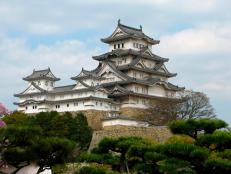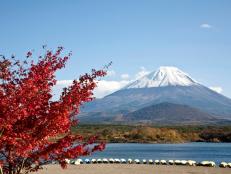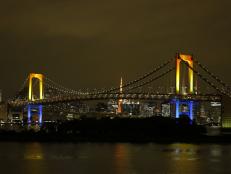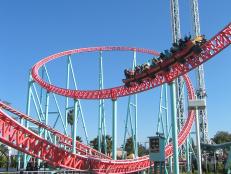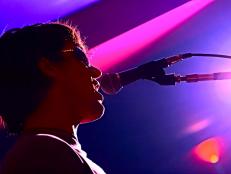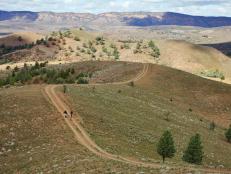10 Hidden Gems in Japan's Setouchi Region
From world-class cycling routes to ancient hot springs, Japan's Setouchi region is filled with treasures.
Related To:
lessRelated To:
Akinada Bridge
Setouchi has been called "a thousand islands set in the sparkling inland sea," and the region, made up of seven prefectures and the Seto Inland Sea, is known for its breathtaking scenery and rich history and culture.
Here, shades of lavender, pink and orange tint the sky over Akinada Bridge in the Hiroshima prefecture. It’s part of Tobishima Kaido, a 29-mile route for cyclists, pedestrians and drivers that connects various islands to the mainland. If you visit in the spring, look for beautiful cherry blossoms as you wind along the coast and pass through picturesque towns. The blooms hit their peak from late March to early April.
Cycling Shimanami
The crowds in Setouchi swell during Cycling Shimanami. This year's event is scheduled for Oct. 28, 2018. Beginners to experts are welcome to bike along Japan’s Shimanami Kaido, another network of roads and bridges; this one runs for 37 miles, links six islands and offers designated paths for cyclists and pedestrians the entire way. The scenery along the route is stunning, and participants pass cultural attractions like the Japanese Buddhist Kosan-Ji temple complex.
Naruto Whirlpools
Some of the biggest, most violent whirlpools in the world are in Naruto, in Setouchi's Tokushima prefecture. Whipped up by a swift current in a strait between the Pacific and the Seto Inland Sea, the whirlpools can reach 66 feet in diameter. Board a sightseeing boat and you can get close enough to hear the waters roar, but ask about the best time to go. The power of the whirlpools changes with the tides.
Okayama Castle
Okayama Castle, also known as Crow Castle for its black-lacquered exterior, gleams in the sun on clear days. Completed in 1597, it was rebuilt after a 1945 air raid. Climb to the fifth floor for a close-up view of the castle's gilded fish-gargoyles and snap photos of the beautiful Ashai River. Before you leave, try on a royal kimono, explore artifacts and historical exhibits, or take a workshop and learn to make bizenyaki, traditional Japanese pottery.
Hiroshima Oysters
Visitors might not associate oysters with Hiroshima, but the city has cultivated them since the 16th century and accounts for most of the country’s output. Take in an oyster festival if you’re in Setouchi during oyster season (January and February), or visit oyster huts and restaurants that serve the meaty mollusks year-round. You can have them steamed, fried, grilled, chowdered, curried or au gratin. Tangy ponzu, a soy-based sauce made with lemon and orange juices, is a popular dipping sauce and marinade.
Miyama Temple
Look for the famous "floating" Torii gate at the Itsukushima Shrine on the island of Miyama. The gate, believed to mark the boundary between the human and spirit worlds, only appears to float when the tides are high. At low tide, you can walk out to the Torii, which stands about 54 feet tall. If you visit, plan to stay in a ryokan, a Japanese-style inn that offers futon beds, tatami floors and meals made from local and seasonal foods.
Guntû Hotel
Board a "floating hotel"—the guntu, a luxury ship—and cruise the Seto Inland Sea. Guests who book one of its 19 Japanese-style cabins can enjoy a communal bath, sushi bar, tearoom, sauna, gym and other amenities, or opt to disembark, as they cruise from island to island, for morning walks, moon-viewings and other activities, depending on the season.
Dogo-onsen Hot Springs
Enter the communal bathhouse at Dogo-onsen, in the Ehime prefecture, and immerse yourself in the 3,000-year-old springs. A watchtower with red glass windows stands atop the wooden structure, which dates back to 1894. After you’ve soaked and enjoyed some tea, catch a rickshaw to shop for souvenirs or dine in the surrounding neighborhood. A museum, shrine and temple are a short walk or bus ride away.
Naoshima Island Pumpkin
A large, red pumpkin on Naoshima represents how nature and art meet on this remote island, one of 3,000 in the Seto Inland Sea. (Kids and adults can go inside the pumpkin, which lights up at night.) All the structures on this art-inspired island are either built into the earth or designed to blend with the landscape. Visitors can also see artwork by Claude Monet, Walter De Maria and others in Naoshima's Chichu Art Museum, or stay in the Benesse House, which is a combination hotel and contemporary art museum. Photo by Daisuke Aochi. Red pumpkin, Yayoi Kusamu, 2006 Naoshima Miyanoura Port Square
Rabbit Island
Animal lovers, don't miss Rabbit Island, accessible by ferry from Hiroshima. Poison gas was produced on the island during World War II, but today, hundreds of wild hares scamper through the woods, and they're considered symbols of safe childbirth and the blessings of numerous children. There are no predators around to eliminate the bountiful bunnies, which may have descended from a few introduced by children in 1971. After you’ve Instagrammed your way through the hoppity herds, head to the beach, play tennis at the island resort or soak in the hot springs.
